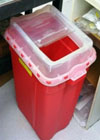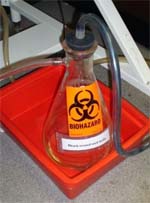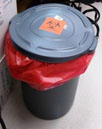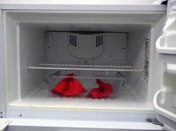This guide is intended to serve as a general informational guide. Please email biosafety@vumc.org or call 615-322-0927 for specific questions related to your waste and handling practices.
Biohazardous waste includes research-related wastes that are contaminated with recombinant or synthetic nucleic acids, agents infectious to humans, animals or plants, or fluids that may contain these contaminants. This waste needs to be collected, stored, treated and disposed of using practices that minimize spill and exposure risk for lab personnel, service workers and the general public. To support this principle, all biohazardous wastes need to be stored inside the lab while awaiting pickup.
| Sharps | Liquid Biowaste | Solid Biowaste | Tissue Biowaste |
Sharps

This sharps container opening should be closed when not in use.
Description/Examples
This includes items which are sharp enough to puncture skin and contaminated with unsterilized biological materials. Example devices include:
- needles & lancets,
- scalpels & razor blades,
- glass slides,
- glass Pasteur pipettes,
- biologically-contaminated broken glass.
This category also includes all sharps-associated medical devices (i.e., syringes).
Collection & Storage
These devices need to be placed into a sharps container immediately after use. Sharps containers are biohazard-marked, solid-walled, puncture-proof containers that are leak-proof on the sides and bottom.
NOTE: Sharps containers must be containers designed for that purpose. Cardboard boxes or repurposed food/beverage containers are not acceptable!
Sharps container lids have a restricted access opening to prevent devices from being accessed once inside the container. Assure that the lid is properly and completely installed before using it for sharps collection. If the opening requires you to drop the device in vertically, it should be closed when the container is not in use. Keep the container free of visible contamination and store it in an upright position.
Treatment & Disposal
Permanently close the container when it is 3/4ths full or when items do not freely fall into the container, regardless of the fullness level. (Do not force objects into a container or shake the container to make more space!) Place full containers in the designated biohazardous waste pickup point.
At VUMC, sharps containers are collected by Environmental Services or an outside vendor and ultimately treated and disposed of by an outside vendor. If containers will be picked up by an outside vendor (i.e., Biowaste LLC or Stericycle), place the closed container in the vendor-supplied waste container for pickup and disposal.
Liquid Biohazardous Waste

Description/Examples
This includes bulk biological liquids such as culture media, pooled clinical specimen liquids, etc.
Collection & Storage
Vacuum flasks and liquid “pour-off” containers should be charged with disinfectant prior to use to help prevent growth of contamination in the flask during the holding period. Collection vessels need to be labeled with the biohazard label and name of the disinfectant. Non-breakable vessels should be used whenever possible.
Vacuum flasks should be stored in a non-breakable and leak-proof secondary container when not maintained inside a biosafety cabinet (BSC). Vacuum flasks must also be equipped with an overflow flask and/or HEPA filter on the line to protect vacuum lines in the event of a flask malfunction. Flasks should be discharged and cleaned weekly, or when they are half-full, whichever comes first, to prevent overflow and prevent growth of contaminants.
Treatment & Disposal
Treated liquid waste may be disposed of via the lab sink. Use a lab coat, gloves and splash goggles (or safety glasses with a face shield) when discharging waste to the drain. Use care to minimize generating “splash back” and thoroughly rinse the sink following waste discharge.
Liquid waste may also be autoclaved and then disposed of via the sink. NOTE: If you will autoclave your waste, you should not pretreat with disinfectant, or you should instead use only a disinfectant that is safe to autoclave based on information from the manufacturer. Bleach is not safe to autoclave.
Solid, non-sharps biohazardous waste
Description/Examples

This includes lab consumables that have come in contact with viable biological materials that contain recombinant or synthetic nucleic acids, clinical specimens in a lab setting, and any lab materials that are regarded as potentially infectious. Examples include:
- gloves used for biological material manipulations,
- disposable culture flasks, serological pipettes, pipette tips and well plates,
- waste items contaminated with blood in a manner that would present a personnel exposure risk (i.e., more than incidentally contaminated).
Collection & Storage
Collect waste in a solid-walled, leak-proof container lined with an autoclaveable biohazard bag. The container needs to have a lid and be marked with the biohazard symbol. The container needs to be closed when not actively in use.
Bench-top biohazardous waste containers should meet the same criteria. Bags should be secured closed and transferred to the floor container when full. If the container has no lid, the bag needs to be securely closed and transferred to the floor container at the end of the day.
Waste generated in a BSC should be collected in a biohazard container inside the BSC whenever procedures permit.
Collect serological pipettes separately (i.e., placed in pipettekeeper boxes, in a dedicated bag, or in a box lined with a biohazard bag) in order to prevent bag puncture during the waste handling process.
Treatment & Disposal
Bags should be securely closed and placed in an appropriate leak-proof secondary container for transfer to the designated biohazardous waste pickup location. (Heavy bags should be double-bagged to prevent leakage during the handling process.)
- VUMC research and clinical areas now use the Sani-Pak sterilization system to sterilize red bag biohazardous waste. (VUMC research buildings include Medical Center North, Light Hall, Medical Research Building IV, Robinson Research Building and Preston Research Building.) Refer to VUMC Lab Guide: Red Bag Biowaste Collection SaniPak FAQ for procedures and pick up locations.
- If bagged waste will be picked up by an outside vendor (i.e., Biowaste LLC or Stericycle), place the securely closed bag in the vendor-supplied waste container for pickup and disposal. These waste bags are autoclaved or incinerated for final treatment.
Always store bagged waste in a secondary container designed to contain a leak. (Double-bagging alone is not sufficient to contain a leak if the bags are ruptured.) Bagged waste treated on site must be treated using an established autoclave cycle that has been validated for effective sterilization of this waste. Waste picked up by Environmental Services is treated in this manner.
Tissue biowaste
Description/Examples
This includes any unfixed animal or human tissues (including organs and bones) that have been used in a research lab.

Collection & Storage
Tissue wastes should be collected:
- in sealable plastic bags marked with a biohazard symbol, or
- a biohazard bag that is securely closed.
Bagged tissues should be placed in a secondary container that will contain a leak (i.e., a plastic bin such as shown in picture to the left), and then placed in a designated cold storage unit with a biohazard label.
Treatment & Disposal
Tissue waste needs to be incinerated for effective treatment and disposal. Mechanisms for disposal include:
- Tissue waste and carcasses generated from an animal protocol may be returned to the DAC facility where animals were housed.
- Contact OCRS Biosafety (322-2057) for one-time, small quantity pickup and disposal.
- Contact Stericycle (www.stericycle.com) to establish a pickup service for ongoing or large volume disposal needs associated with research or teaching activities.
Biological Waste Spill Reminders
- If you generate liquid-based biohazardous waste, you need to have supplies on hand and follow procedures outlined in Responding to Personnel Exposures and Spills Involving Biological Materials.
- If a spill of untreated waste occurs in a public area, close off or keep others out of the area. You must report these spills to OCRS Biosafety (2-2057) immediately.
Biological material exposure response
If biological materials enter your body through: a cut or puncture sustained from a contaminated sharp object, contact with damaged skin or a splash to the eyes, nose or mouth, do the following:
- Proceed to the closest sink and flush the exposure site for 15 minutes.
- Report the exposure to your lab supervisor if they are available.
Report to the Occupational Health Clinic for medical follow-up as soon as possible. If exposure involved human-derived materials, timely assessment is critical. Report to the Vanderbilt Adult Emergency Department if Occupational Health is closed. Exposures involving recombinant or synthetic nucleic acids requiring BSL-2 containment must also be reported to OCRS Biosafety (2-2057) as soon as possible once medical follow-up is initiated.